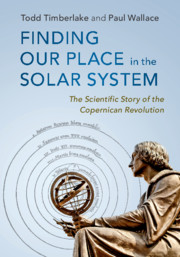Book contents
- Frontmatter
- Dedication
- Contents
- Preface
- 1 Introduction: mysterious skies
- 2 Two spheres: modeling the heavens and the Earth
- 3 Wanderers: the Moon and the planets
- 4 An Earth-centered cosmos: astronomy and cosmology from
- 5 Moving the Earth: the revolutions of Copernicus
- 6 Instruments of reform: Tycho’s restoration of observational
- 7 Physical causes: Kepler’s new astronomy
- 8 Seeing beyond Aristotle: Galileo’s controversies
- 9 The system of the world: Newton’s universal physics
- 10 Confirming Copernicus: evidence for Earth’s motions
- Appendix Mathematical details
- Notes
- References
- Index
2 - Two spheres: modeling the heavens and the Earth
Published online by Cambridge University Press: 18 March 2019
- Frontmatter
- Dedication
- Contents
- Preface
- 1 Introduction: mysterious skies
- 2 Two spheres: modeling the heavens and the Earth
- 3 Wanderers: the Moon and the planets
- 4 An Earth-centered cosmos: astronomy and cosmology from
- 5 Moving the Earth: the revolutions of Copernicus
- 6 Instruments of reform: Tycho’s restoration of observational
- 7 Physical causes: Kepler’s new astronomy
- 8 Seeing beyond Aristotle: Galileo’s controversies
- 9 The system of the world: Newton’s universal physics
- 10 Confirming Copernicus: evidence for Earth’s motions
- Appendix Mathematical details
- Notes
- References
- Index
Summary
The stars move from east to west across the sky each night. The ancient Greeks realized that the apparent movement of the stars would make sense if the stars were stuck on the inner surface of a giant celestial sphere that rotated around the Earth once every sidereal day. The Sun also moves from east to west across the sky, but not quite in the same way as the stars. The Sun’s motion can be tracked using shadows, and it appears to move eastward relative to the sphere of the stars along a path that is tilted relative to the celestial equator. The Sun completes its motion around the celestial sphere in one year, traveling through the constellations of the zodiac along a path called the ecliptic. As an observer moves around on Earth the apparent motions of the stars and Sun change in a way that shows the Earth to be spherical. The stars also display a very slow motion known as the precession of the equinoxes with a period of about 26,000 years.
- Type
- Chapter
- Information
- Finding our Place in the Solar SystemThe Scientific Story of the Copernican Revolution, pp. 13 - 48Publisher: Cambridge University PressPrint publication year: 2019

